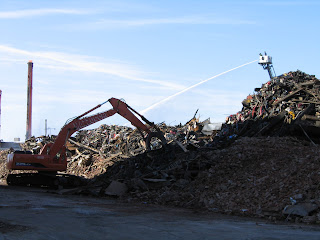The annual Environmental Conference of the Professional Abatement Contractors of New York (PACNY) was held at
Turning Stone Casino & Resort in
Verona, New York. This annual conference has become synonomous with changes - either changing the way we think, new regulations, or new interpetations.
 |
| Dr. David Duford from CanAm Environmental, Angelo Garcia, III from FED, & Darren Yehl from Cornerstone Training on the PACNY Discussion Panel |
This year's changes (not sure that is the right word, but we will use it anyway), include lengthy discussions about
vermiculite (any vermiculite in a sample designates the sample as containing asbestos), and ceiling tiles analysis by Dr. Stephanie Ostrowski of the Environmental Laboratory Approval Program (ELAP). After last year's PACNY presentation by ELAP and various questions from the audience, ELAP released the April FAQ which answered questions and created new questions regarding a number of items. Major points from Dr. Ostrowski was materials similar to NOBs such as ceiling tiles and fiberglass (where the materials may block or interfere with analysis of asbestos) should be analyzed using gravimetric reduction. Probably one of the most frustrating parts of Dr. Ostrowski's presentation is her using the word "should" when most in the audience thought she should have used "shall or must". For example, in discussing the vermiculite issue she said laboratories should consider the material asbestos contaminated. If the material cannot be analyzed for the contamination of asbestos, why is it "should" why not "shall". From a suggestion from the audience, Dr. Ostrowski was going to go back and discuss with her collegues the adding of a disclaimer for vermiculite on laboratory reports.
The usual highlight of the conference was the update by Mr. Chris Alonge on the progress of the revisions to Industrial Code Rule 56. Dr. David Duford from CanAm Environmental Safety, Inc. did an excellent presentation, before Mr. Alonge's, on the New York State Building and
Fire Code which allowed everyone to have a better idea what Mr. Alonge is referencing in the revisions. Probably the most important announcement by Mr. Alonge was that the New York State Department of State has approved the changes and their review is completed. The next hurdle is the NYS Division of Budget, and we will see what happens next on that front. Mr. Alonge said he hoped for a comment period this summer with possible enactment by the beginning of 2013. We recently got an electronic copy of his presentation for this year and that will be added to our manuals (
eventually to our website, too) along with the bulk sample analysis decision trees provided by Dr. Ostrowski.
The conference started with a presentation by Mr. Tom Meade the Executive Director of PACNY and discussions on the need for moral & ethics training in the industry, the micro-managing of the industry, a Bill to Amend Section 904 of the Labor Law, recent finding that sprayed-on fireproofing installed in 2005 came back with 2% chrysotile asbestos, and the findings of the FOIL request regarding
New York State Department of Labor's Asbestos Control Program budget & notification fees. Brian Sampson of Unshackle Upstate then discussed the importance of his organization's work in providing a balanced voice for upstate New York, his points regarding the industry was support for tax credits for remediation, support for amending Section 904, and streamlining permitting process.
Other speakers included, Mr. Paul Watson from ATC Associates spoke about
PCBs (important point - EPA Guidance Document on Caulk, may become the industry standard); Mr. Bob Krell from
IAQ Technologies; Mr. Kevin Murphy from Wladis Law Firm (what to do if an allegation is made against you? - know your rights, know you do not have to say anything, know that saying something can have much more serious consequences than saying nothing, etc.); and Mr. Ron Williams from OSHA (National Emphasis Programs on silica, lead, trenching & excavation). The exhibition hall was a little light this year because of conflicts with other meetings, however, DiVal Safety Equipment had an interesting product Rhinotuff Puncture Resistant Insoles (
DiValSafety.com). This product is designed to fit into most types of work boots and shoes to provide puncture resistance. A new vendor at the show was The SAFETY house.com, visit them at
www.thesafetyhouse.com.
A big Thank You! to PACNY for inviting me onto the panel discussion this year. I was honored and enjoyed the conference as usual.






